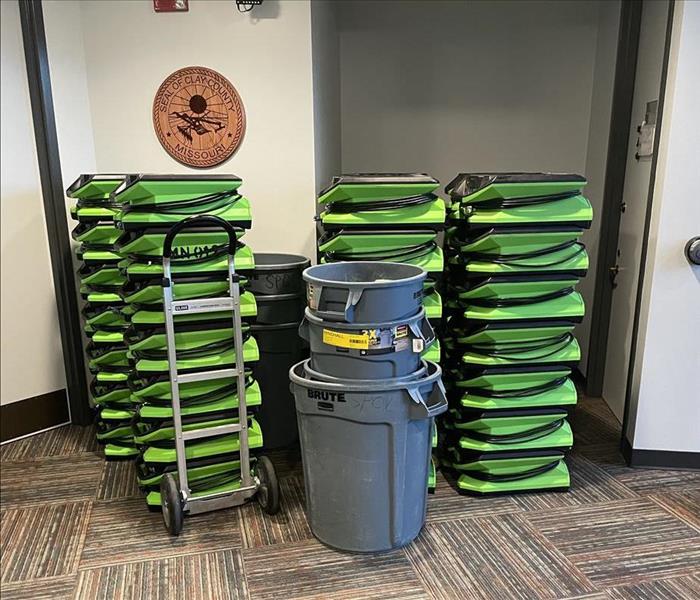Understanding Water Loss and the Role of Air Movers in Water Damage Restoration
6/20/2024 (Permalink)
Water damage is a common yet devastating problem that can strike homes and businesses at any time. Whether due to a natural disaster like a flood, a plumbing mishap, or an appliance failure, water intrusion can cause significant property damage and pose serious health risks. Effective water damage restoration is crucial to mitigate these effects, and one of the most critical tools in this process is the air mover.
What is Water Loss?
Water loss refers to the unwanted presence of water in areas where it can cause damage to structures, furnishings, and personal belongings. The severity of water loss can vary, ranging from minor leaks to major flooding events. Understanding the category and class of water loss is essential for determining the appropriate restoration approach.
- Category 1: Clean water from sources like broken water supply lines or overflowing sinks. This type of water poses no substantial risk to health.
- Category 2: Gray water, which can cause illness if ingested. This category includes water from washing machines, dishwashers, or toilet overflows with some contaminants.
- Category 3: Black water, which is highly contaminated and can cause severe illness or death if ingested. This includes sewage, floodwater, or any water containing fecal matter.
Water loss is also classified by the extent of the damage:
- Class 1: Minimal water absorption affecting part of a room or area.
- Class 2: Significant water absorption affecting an entire room, including walls and carpeting.
- Class 3: Greatest amount of water absorption, typically from overhead sources, saturating the ceiling, walls, and floor.
- Class 4: Specialty drying situations with deeply saturated materials such as hardwood, plaster, and concrete.
The Critical Role of Air Movers
Air movers, also known as industrial blowers or fans, are essential tools in the water damage restoration process. They play a vital role in drying out affected areas quickly and efficiently, helping to prevent further damage such as mold growth and structural weakening.
How Air Movers Work
Air movers work by creating a high-velocity airflow over and around wet surfaces. This increased air circulation enhances evaporation, significantly speeding up the drying process. They are strategically placed to ensure that the maximum amount of air reaches all affected areas, including hard-to-reach spaces like under carpets and inside walls.
Types of Air Movers
There are several types of air movers used in water damage restoration, each suited for different situations:
- Centrifugal Air Movers: These are compact and powerful, ideal for focused drying. They are commonly used for drying carpets, floors, and walls.
- Axial Air Movers: These produce a large volume of airflow and are used to dry larger areas. They are particularly effective in drying out entire rooms and large spaces.
- Low-Profile Air Movers: Designed to fit in tight spaces, these air movers are perfect for drying under cabinets, crawl spaces, and other confined areas.
Benefits of Using Air Movers
- Accelerated Drying Time: By promoting rapid evaporation, air movers drastically reduce the drying time, minimizing the potential for mold growth and structural damage.
- Energy Efficiency: Modern air movers are designed to be energy-efficient, ensuring that the drying process does not lead to exorbitant energy costs.
- Versatility: Air movers can be used in various scenarios, from small residential water losses to large-scale commercial water damage situations.
- Mold Prevention: Quick and thorough drying prevents mold spores from settling and growing, protecting indoor air quality and health.
SERVPRO's Expertise in Water Damage Restoration
At SERVPRO, we understand the critical importance of a swift and efficient response to water loss incidents. Our team of highly trained professionals is equipped with the latest air movers and other advanced drying equipment to ensure comprehensive restoration. We follow a meticulous process that includes:
- Assessment: Identifying the category and class of water loss to determine the appropriate restoration strategy.
- Water Extraction: Removing standing water using powerful pumps and vacuums.
- Drying and Dehumidification: Utilizing air movers and dehumidifiers to eliminate moisture from all affected areas.
- Cleaning and Sanitizing: Thoroughly cleaning and sanitizing surfaces to remove contaminants and prevent mold growth.
- Restoration: Repairing and restoring damaged areas to their preloss condition.
Conclusion
Water damage can be a challenging ordeal, but with the right tools and expertise, it is possible to restore your property efficiently and effectively. Air movers play an indispensable role in the drying process, ensuring quick recovery and minimizing long-term damage. Trust SERVPRO for all your water damage restoration needs – we are here to make it "Like it never even happened."
For more information or immediate assistance, contact SERVPRO today. Our team is available 24/7 to provide expert water damage restoration services.




 24/7 Emergency Service
24/7 Emergency Service
